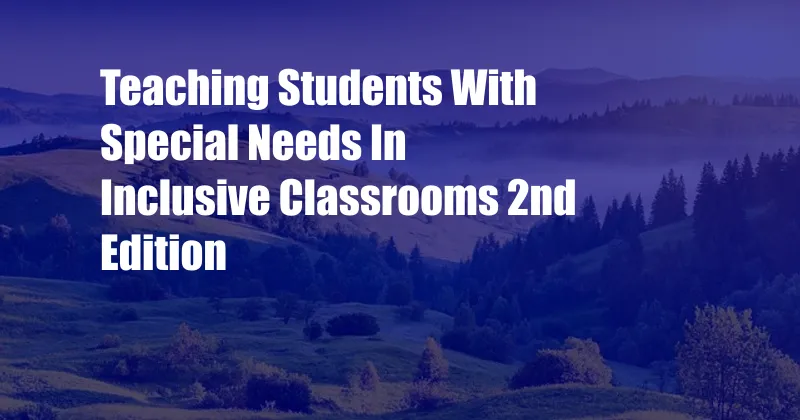
Teaching Students with Special Needs in Inclusive Classrooms: A Comprehensive Guide
Imagine a classroom where every student feels valued, respected, and has the opportunity to reach their full potential. A classroom where diversity is celebrated, and everyone learns and grows together. This is the vision of an inclusive classroom, a place where students with special needs thrive alongside their peers.
In today’s increasingly diverse society, inclusive classrooms are more important than ever. They provide students with special needs the opportunity to experience a sense of belonging, develop social skills, and achieve academic success. But creating an inclusive classroom is not without its challenges. Teachers need to be equipped with the knowledge and skills to meet the needs of all learners.
A Journey Towards Inclusion
In 2010, the Teaching Students with Special Needs in Inclusive Classrooms (TSSNIC) guide was published, providing a comprehensive framework for educators seeking to create inclusive learning environments.
Now, in its second edition, TSSNIC 2nd Edition builds on the success of its predecessor, offering an updated and expanded guide to inclusive education. This groundbreaking resource provides practical strategies, case studies, and up-to-date research on teaching students with special needs in inclusive classrooms.
Understanding Inclusive Classrooms
An inclusive classroom is one in which all students feel valued and respected, regardless of their abilities or disabilities. It is a place where every student has the opportunity to learn and grow, and where diversity is celebrated.
Inclusive classrooms are not about making students with special needs fit into a traditional classroom setting. Instead, they are about adapting the classroom to meet the needs of all learners. This may mean providing students with assistive technology, modifying assignments, or offering additional support.
Creating an Inclusive Classroom
Creating an inclusive classroom requires a commitment from both the teacher and the students. Teachers need to be willing to learn about and understand the needs of their students, and they need to be flexible and creative in their teaching methods.
Students also need to be encouraged to be inclusive. They need to learn about the different ways people learn and be respectful of everyone’s differences. By creating a positive and supportive learning environment, teachers can help all students reach their full potential.
Research and Trends
Research has shown that students with special needs who are educated in inclusive classrooms make significant progress both academically and socially. They are more likely to develop social skills, make friends, and have a positive self-image.
In recent years, there has been a growing trend towards inclusion in education. More and more schools are adopting inclusive practices, and teachers are receiving more training on how to meet the needs of students with special needs.
Tips and Expert Advice
There are many things teachers can do to create an inclusive classroom. Here are a few tips from experts:
- Get to know your students. Learn about their strengths and weaknesses, and be open to adapting your teaching methods to meet their needs.
- Create a positive and supportive learning environment. This means respecting all students, valuing their differences, and setting high expectations for everyone.
- Be flexible and creative in your teaching methods. Not all students learn in the same way, so be prepared to experiment with different approaches.
- Collaborate with other professionals. This could include other teachers, special education teachers, and therapists. By working together, you can ensure that all students are getting the support they need.
By following these tips, teachers can create inclusive classrooms where all students feel valued, respected, and have the opportunity to reach their full potential.
FAQs on Inclusive Classrooms
Q: What are the benefits of inclusive classrooms?
A: Inclusive classrooms benefit all students, not just those with special needs. They provide students with the opportunity to learn about and interact with people who are different from them. This helps to develop empathy, tolerance, and understanding.
Q: What are the challenges of inclusive classrooms?
A: One of the biggest challenges of inclusive classrooms is meeting the needs of all learners. This may require teachers to adapt their teaching methods, provide additional support, and collaborate with other professionals.
Q: How can I create an inclusive classroom?
A: There are many things teachers can do to create an inclusive classroom. By getting to know their students, creating a positive and supportive learning environment, being flexible and creative, and collaborating with other professionals, teachers can ensure that all students have the opportunity to succeed.
Conclusion
Creating inclusive classrooms is an ongoing process. It requires a commitment from both teachers and students. But the benefits are worth it. When students with special needs are included in general education classrooms, they learn more, make friends, and develop a positive self-image. And when all students are included, everyone benefits.
Are you interested in learning more about inclusive classrooms? Let’s continue the conversation in the comments below.